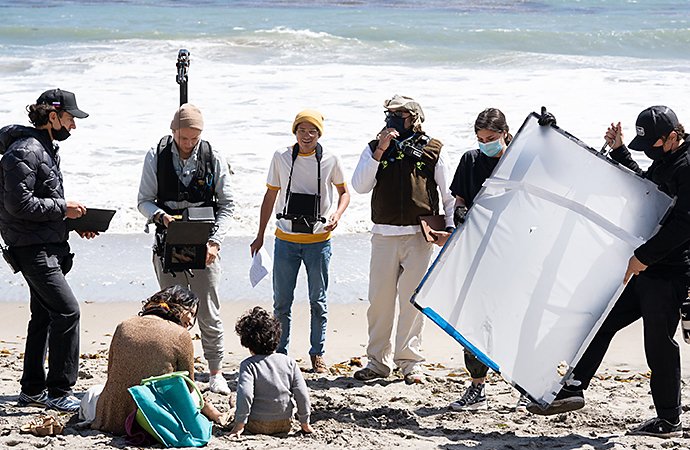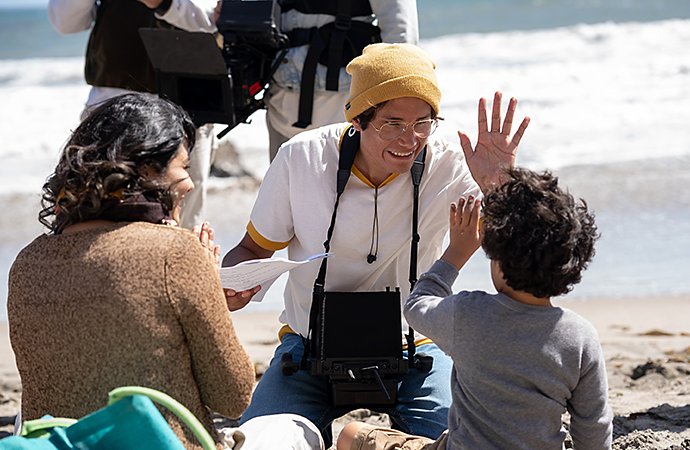Short film ideas: Get inspired to tell a story.
A great short film can be your entry point into the world of filmmaking. Discover how to tap into your inspiration and take your idea from script to festival.

The short stories of the film world.
A short story can be just as compelling as a novel. In the same way, good short films contain the same storytelling elements as good feature films — an inciting incident, a conflict, and a resolution — just in a smaller package. Every genre has its shorts: documentary, drama, horror, romance, and more.
“A short film is a snippet. It could be two minutes, it could be 23,” says film director Helen Alexis Yonov. “But it gives you a slice of life with a complete beginning, middle, and end that stands on its own. I think short films should be respected because it’s hard to create something in eight minutes that has meaning.” A great short film can influence audiences, win awards at film festivals, and become the calling card that gets you a job in film or video production.
Fifteen or less is festival-friendly.
Short films are generally five to 15 minutes long. Some are longer, some are shorter. Micro-shorts are under five minutes. Once you get to 50 minutes, that’s a feature film. “As a rule of thumb, I would say keep it under 15 minutes because of film festival lengths,” says Yonov. “And if you have something at eight minutes that is captivating, you don’t need more. A short film will tell you how long it needs to be.”
Brainstorm short film ideas.
As with short videos in the marketing world, a short film’s success depends on audience engagement. But perhaps more importantly, a good story for a film comes from an idea that first captivates the screenwriter. The goal is to come up with script ideas that are important to you and then find a way to make them interesting for the audience.
“Be unique. Be captivating. And make what speaks to you as a filmmaker,” says Yonov. “When you’re thinking about your audience, you don’t want to solely think, ‘Is so-and-so going to love this and give me a job?’ You’re doing it for yourself as well.”
Look for story ideas everywhere you go.
Films can come from anywhere — an overheard conversation, a beautiful painting, a news story. Significant moments in your own life, musings you have about the lives of others, or real life events from the news can all be the inspiration for a film.
As you are brainstorming movie ideas, remember that all it takes is one captivating spark. “Maybe I read an article in a magazine and think, ‘Wow, that’s fascinating. Let’s take everything about it and throw it out the window, but keep this one little gem and run with it,’” says Yonov. “The big thing is to find the gem in the story, what draws you to it.”
Train yourself to be open to inspiration, and keep yourself busy with new experiences, even if it’s just watching a new movie, reading a new book, or visiting a coffee shop you’ve never been to before. When you go out, bring a small notebook or use the note-taking app on your phone, so you always have somewhere to jot down your ideas.

“I come up with a story in the moment, and then I write down a little glimpse of it in the notes app on my phone,” says film director Jhosimar Vasquez. “Then I go back to it when I get home, and I try to expand on it and put music to my idea.”
If you’re having trouble finding a complete story in what you experience, ask yourself some “what if” questions about the events around you. What if your ex showed up at your door? What if that man you saw on the subway was on his way to meet his father for the very first time? What if the news story you just read was told from another perspective?
One way to get inspired is to tell stories based on social issues that you care about. “I try to connect my ideas to something true in life,” says Vasquez. “When I feel like I have to tell a story to the world, that’s when I know I’m doing good.”
Try to find an emotion related to an event and see how you might convey that to an audience. “Ask yourself, ‘What do you want viewers to feel?’ Go from the feeling of what you felt in the moment. Guide yourself from there,” says Vasquez. “I once was watching camera footage of a girl escaping Syria. I absorbed the reality from all of that to feel what she was feeling. Once you feel it, that’s the ticket to a great script.”
A short film can help you reframe a difficult moment in your own life or someone else’s into something that helps others. “I see trauma in my life. I see it everywhere, every day,” says Vasquez. “Filmmaking is a way to step out of my comfort zone and turn trauma into something else, to morph it.”
Succeed at short film screenwriting.
A short film script should be around five to 15 pages. Typically, one page of writing equals one minute of film. Keep it simple. It can be easy to get carried away and try to accomplish too much with a short film. “You need to follow just one idea, one throughline,” says Yonov. “It's like being in a forest — you’ve got all these paths that you can go down. Follow one path, or you’re going to get lost.”

Give your rough drafts to people you trust who can read them and give you feedback. The critiquing process will help you cut out anything that isn’t directly related to your main storyline. But you don’t need to follow all feedback — trust your instincts when it comes to telling your story.
Get to know your characters.
The more you shape your characters as complete people, the easier it will be to write about them. Even for a short film, create an in-depth character breakdown for all of your main characters. Play it like a game of 50 questions.
Your characters’ actions and reactions will seem more realistic if they’re based on these breakdowns. For example, a character might be standoffish with their dad in one scene because of a difficult relationship. “You’re not wondering how your character will react," says Yonov. “Instead, the dialogue comes naturally, because you know what this character is all about.”
Not all short films require complete storyboards of how each scene will appear, but you should put thought into how you want your characters and settings to look. Start with a moodboard or a visual lookbook for your characters, locations, and the desired look and feel of your cinematography. Include your own photos or inspirational imagery that you’ve found through research.
A moodboard or lookbook will help your team understand your vision, so they can help you achieve it. And the more detail you can provide, the better. “I started making more developed moodboards, where I’m talking shadows, I’m talking music, I’m talking lighting, I’m talking angles, I’m talking tones,” says Vasquez. “I’ve literally prepared a 40-page presentation for my director of photography.”
Finance and shoot your short movie.
Find funding.
Unless you’re a Coppola, your first short film will be an indie, or independent film. This means you won’t have the funding that comes with being backed by a big studio or Hollywood production company. The low budgets of first-time filmmakers are a challenge, but that can be solved.
“If you have the money, invest in yourself. If you don’t have the money, find the people that will invest in you and the crew around you,” says Yonov. “Then take your camera, take your iPhone, take whatever you have and just shoot. Don’t let not having $100,000 or $50,000 or $10,000 stop you from shooting.”


Images by Jhosimar Vasquez
Establish a film crew.
Breaking into the film industry is all about making connections with others who want the same thing as you. People may agree to work on your film for free or very little pay if you offer to return the favor for them. But never let budgeting stand in the way of food. “Always feed your crew really well. If your crew’s stomachs are not happy, you don’t have a happy crew,” says Yonov.
Build a community with other filmmakers that will be glad to work with you in the future. And if you’re lucky, you’ll find mentors along the way with more experience than you. “Surround yourself with people who know more than you do,” says Yonov. “My cinematographer knows more about lenses, color, and depth of field than I ever will.”
Get everything you need to edit your film with Adobe Premiere Pro — such as adding smooth transitions, Adobe Stock audio clips, and professional titles. Do it all from one app. Then, once your film is finished, export it in any format you need.
Submit to short film festivals.
Submitting to a festival can help give you a deadline for finishing your project and allow you to share your film with the world. Winning awards at certain festivals can also qualify your short film for the Oscars. Qualifying festivals include the Sundance Film Festival, Ann Arbor Festival, Tribeca Film Festival, LA Shorts Fest, Hollyshorts, Austin Film Festival, and many, many more.
Compile a list of film festivals you’re interested in, and write down the genres they accept, their time limits, their submission deadlines, and special rules for submitting. This will help you submit appropriate work at the right time.
Get out there and see how you can realize your vision in the short film format. You could win an Oscar. “Don’t be afraid to try,” says Yonov. “But also don’t be afraid to fail. Don’t be afraid to get out there and go with a bunch of friends and shoot something. You never know. You might get something really good.”
Contributors
Do more with Adobe Premiere Pro.
Make visually stunning videos virtually anywhere — for film, TV, and web.
You might also be interested in…
Establishing shots are crucial because they tell us where, and often when, the action is happening.
Learn how to create a shot list that guides the crew through all of the day’s camera setups.
Shooting scripts: Plan your film production.
Discover what a shooting script is and how to use one to plan and execute a successful video shoot.
Discover the hidden world of Foley sound effects.
See how Foley artists create post-production sound effects and where it fits within sound design.
Get Adobe Premiere Pro
Create flawless productions with the industry-leading video editing software.
7 days free, then RM110.16/mo.



